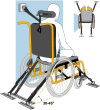Wheelchair tiedown and occupant restraint practices in paratransit vehicles
- PMID: 29304035
- PMCID: PMC5755728
- DOI: 10.1371/journal.pone.0186829
Wheelchair tiedown and occupant restraint practices in paratransit vehicles
Abstract
The purpose of this study was to characterize wheelchair tiedown and occupant restraint system (WTORS) usage in paratransit vehicles based on observations of wheelchair and scooter (wheeled mobility devices, collectively, "WhMD") passenger trips. A retrospective review of on-board video monitoring recordings of WhMD trips was conducted. Four hundred seventy-five video recordings were collected for review and analysis. The use of all four tiedowns to secure the WhMD was observed more frequently for power WhMDs (82%) and manual WhMDs (80%) compared to scooters (39%), and this difference was significant (p< 0.01). Nonuse or misuse of the occupant restraint system occurred during 88% of WhMD trips, and was most frequently due to vehicle operator neglect in applying the shoulder belt. Despite the absence of incidents or injuries in this study, misuse and nonuse of WTORS potentially place WhMD seated passengers at higher risk of injury during transit. These findings support the need for improved vehicle operator training and passenger education on the proper use of WTORS and development of WTORS with improved usability and/or alternative technologies that can be automated or used independently.
Conflict of interest statement
Figures










References
-
- Shaw G. Wheechair rider risk in motor vehicles: a technical note. J Rehab Res Develop. 2000;37:89–100. - PubMed
-
- Transportation Research Board. TCRP Synthesis 50: Use of rear-facing position for common wheelchairs on transit buses. Washington DC,2003.
-
- Americans with Disabilities Act of 1990. Pub. L. No. 101–136.
-
- Frost KL, Bertocci G, Salipur Z. Wheelchair securement and occupant restraint system (WTORS) practices in public transit buses. Assistive Technology. 2013;25:16–23. doi: 10.1080/10400435.2012.680660 - DOI - PubMed
-
- ANSI/RESNA. Section 18—Wheelchair tiedown and occupant restraint systems for use in motor vehicles. in ANSI/RESNA WC-4:2012, American National Standard for Wheelchairs, Vol 4—Wheelchairs and Transportation. Dec 2012.
Publication types
MeSH terms
LinkOut - more resources
Full Text Sources
Other Literature Sources

